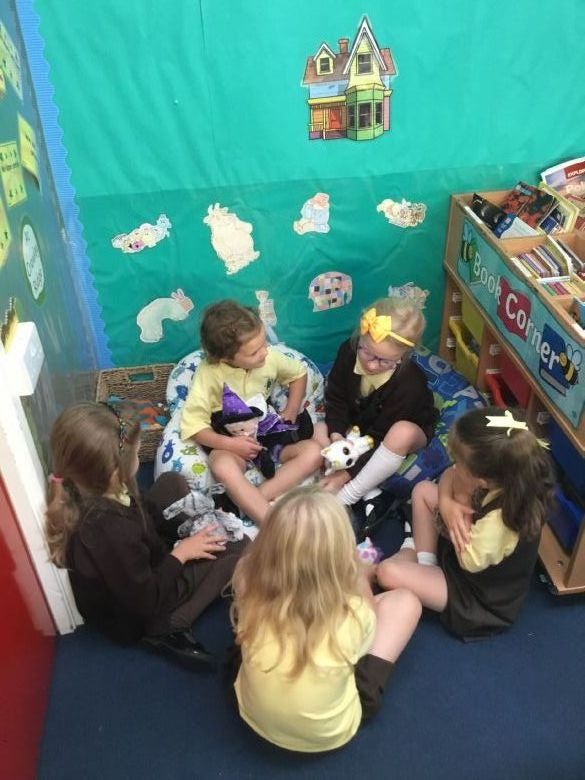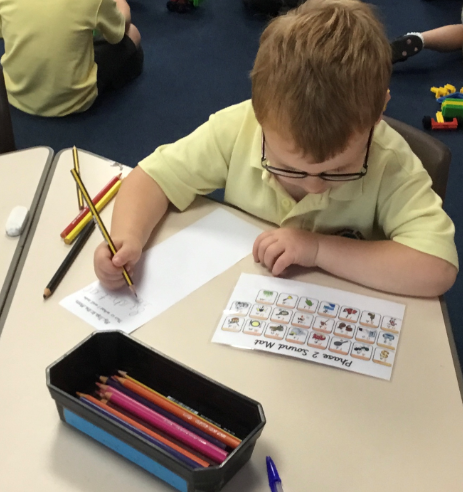English
“The overarching aim for English in the national curriculum is to promote high standards of language and literacy by equipping pupils with a strong command of the spoken and written word, and to develop their love of literature through widespread reading for enjoyment.” National Curriculum 2014
Intent
English is our language. It is how we communicate, and it runs through everything we do in all subjects; like life-blood running through the curriculum! From their earliest moments, children hear sounds all around them. We must teach them not only to hear, but also to listen, and to make sense of the sounds they hear. Sounds become words, and words become sentences. Children learn to express themselves through spoken language and then through reading and writing. None can exist successfully without another – we listen, we speak, we read, we write – and others respond as we respond to them.
By providing strong building blocks and good models to follow, our pupils can become excellent communicators, using the English language in all of its forms. English is necessary, and it is an integral part of all learning.
The National Curriculum for English aims to ensure that all pupils:
- read easily, fluently and with good understanding
- develop the habit of reading widely and often, for both pleasure and information
- acquire a wide vocabulary, an understanding of grammar and knowledge of linguistic conventions for reading, writing and spoken language
- appreciate our rich and varied literary heritage
- write clearly, accurately and coherently, adapting their language and style in and for a range of contexts, purposes and audiences
- use discussion in order to learn; they should be able to elaborate and explain clearly their understanding and ideas
- are competent in the arts of speaking and listening, making formal presentations, demonstrating to others and participating in debate
At Crawley Ridge children learn about:
Spoken Language
- For a wide range of purposes
- In different contexts
- In groups discussion and interaction
- In drama
Phonics
- The 40+ basic sounds (phonemes)
- Alternative graphemes
- Blending for reading
- Segmenting for spelling
Reading
- Word reading skills and strategies
- Comprehension; Understanding and interpreting texts
- Engaging and responding to texts
Writing
- Transcription; spelling, handwriting, punctuation
- Composition; articulating and structuring ideas
Presentation
- Handwriting
- Using word processing skills
Implementation
Please see the Year 1 and 2 Content tabs for more detail on how these areas are taught within each year group in Key Stage 1, and visit the EYFS tab under the Learning page to find out how the basics of English are taught in the Reception Year.
Speaking and Listening
At Crawley Ridge Infant School we use discussion to aid and develop learning across the curriculum. The children are encouraged to elaborate and they are given time to clarify their thoughts and explain their understanding. Through questioning, they are given the opportunity to communicate their thinking and build on their own and each other’s ideas. By ensuring a rich variety of language for the children to hear we help the children to build and use a wide vocabulary. We value everyone’s opinions and the children are taught the importance of taking turns when speaking and of listening carefully both to each other and to adults. The children are therefore able to gain confidence and competence in speaking; enabling them to develop the capacity to communicate clearly.
Phonics
Phonics underpins reading and writing, and is taught regularly throughout the week in all year groups. We use the "Essential Letters and Sounds" Programme in year R to introduce each sound. In Phase 1 children explore sounds in the environment as well as rhymes and rhythms and they may already have had experience of this in their nursery or pre-school. Early in their Reception Year, children are introduced to Phase 2 phonemes (sounds), which they are taught to blend for reading, and to segment for spelling. Gradually, they build upon this as they explore more complex phonic patterns. As they progress through the school and through the "Essential Letters and Sounds" Programme they learn more complex graphemes (written representations of phonemes) including the alternatives for each one.
For further information on the Essential Letters & Sounds Synthetic Phonics Programme, please visit https://essentiallettersandsounds.org/
Reading
Our teaching of Reading involves developing skills necessary for both word reading and comprehension. We believe that children should read as widely as possible. We use a broad variety of materials, including Rising Stars Rocket Phonics, Oxford Reading Tree, Project X, Word Sparks, Alien Adventures, Hero Academy and Little Blending Books. As well as guided reading sessions in school, children take Phonic based reading books to practise at home, and they have access to the Oxford Owl e-library. We closely match materials and teaching to each child's needs as well as to the phonics phases detailed in the ELS programme.
As part of the ELS phonic programme, the children learn to recognise, read and spell some common "Harder to Read and Spell" (HRS) words. (These are referred to in the National Curriculum as "Common Exception Words" (CEW) as they do not follow the rules of the phonics code and must be learned as "exceptions" to the rules.
Through discussions about the books they read with each other, teachers and teaching assistants, children develop comprehension skills across a wide range of stories, poetry and non-fiction texts. Children’s engagement with the text and their response to it is developed through guided reading sessions and individual reading conferences. We value the involvement of parents in helping to ensure that each child reads regularly at home - every day if possible.
As they master the graphemes in Phase 5 and Phase 6, and children develop their word-reading strategies and comprehension skills, they read a wider range increasingly complex texts.
We aim to enable children to read fluently, confidently and with understanding as it "feeds pupils’ imagination and opens up a treasure-house of wonder and joy for curious young minds." - National Curriculum in England 2014
Writing
Our Writing covers two strands; transcription, which includes spelling and handwriting, and composition.
Children practise skills in grammar, spelling and punctuation and apply these in creative writing tasks. Children learn to write for a variety of purposes and in different contexts. Building on their early handwriting skills (using Sassoon Infant Standard font in EYFS), our pupils are taught how they can join some letters in Year 1 and we adopt a cursive script in Key Stage 1 (handwriting.pdf). Children are encouraged to take pride in their work and present it neatly. The children are encouraged to read their work through, checking for any spelling or grammatical mistakes and ensuring it makes sense. By communicating their ideas clearly, using a rich and varied vocabulary and appropriate grammar, the children are taught to write for a purpose and with an awareness of the reader.
Impact
Progress in Spoken Language, Phonics, Reading and Writing are tracked carefully from Reception through to the end of Key Stage 1. Where gaps are identified, extra support will be put in place to ensure that every child can make good progress. For example, children will be given support to articulate sounds correctly in their speech so that they can identify those sounds in reading and to enable them to spell correctly. Towards the end of Year 1 pupils take the National Phonics Screening Check, and at the end of Year 2 Teacher Assessments are completed before pupils transfer to their junior schools. Our pupils will be able to communicate effectively across a range of applications and using language for different purposes - in discussion and debate, to write letters, stories and descriptions, and for their own enjoyment, research and self-development.



